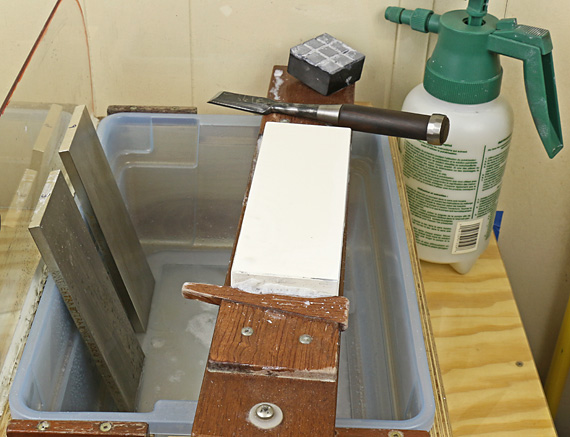
My new, new (ugh) favorite fine finishing stone, the Suehiro Gokumyo, is a real thoroughbred. Nominally 20,000 grit/0.5 µ with a tight distribution of particle size, it can produce magnificently sharp, clean edges.
This is a very hard stone in all respects. A hard, tough binder makes it extremely wear resistant, so it retains a flat surface very well and requires little maintenance. It is virtually non-porous, so no soaking is required – just splash and go.
When first using the Gokumyo, do not expect the genial feel of a Chosera 10K or a soft waterstone. The hard feel of this stone under the steel is initially formidable. However, once you tune in to just how awesomely fast and smooth it is removing steel and adjust your sense of feedback, it becomes an efficient joy to use. Nonetheless, to get the most out of it, you do need good sharpening skills.
The Gukomyo comes with a 1K/3K nagura but I prefer my shop-made 1200-grit diamond nagura to quickly enhance feel and performance. I have not encountered the grabbing or stiction that many of the Shapton stones tend to produce, and one does not need to baby this stone like the Chosera 10K.
Having worked with this stone for several months now, it produces great edges in all the main steels in my shop – A-2, O-1, and Japanese blue and white. I transition from the 8000/3µ DMT Dia-Sharp diamond stone, used with a light touch, to the 20K Gokumyo. True, that is a sizable leap but it works, and it minimizes the number of stones and speeds the process.
The Gukomyo 20K is discussed fairly widely on the internet among straight razor aficionados but has not received much attention from woodworkers. The best and least expensive source for Suehiro Gukomyo finishing stones is Tools From Japan, which is actually based in Japan. Proprietor Stu Tierney is tremendously knowledgeable and generously helpful. [This review is unsolicited and uncompensated.] Yes, this is an expensive connoisseur’s stone but at 20mm thick and so wear resistant, it should last an extremely long time.
With this and the transition to diamond stones, the revolving door of sharpening stones in my shop seems to have thankfully reached an end.
By the way, anyone want to buy some used Shapton glass stones or other sharpening gear at a nice price? (Please send me an mail.)


Rob,
I’m a recent re-convert back to diamond. I much prefer the feel of oil stones but oil stones are not efficient with all steels. My sequence is slightly different, stopping the diamonds at 1200 grit, then a extra fine Spyderco, followed by the Gokumyo for final polish. It gives an incredibly sharp, beautiful polished edge. It uses more stones than I would like but the results are worth the extra steps.
ken
Thanks, Ken. I agree, one set of stones for all steels makes things much simpler and works as a practical matter.
The transition from the 8000/3µ diamond stone to the Gokumyo 20K is a pretty big leap but I sure like the diamond’s speed and it works out well. The nice thing is being able to usually go to the 8000 for resharpening on the secondary bevel, get enough speed and without too big a scratch pattern, then right to the 20K.
Rob
Rob,
Thanks for this post. I have used a Norton 8k and then upgraded to a Sigma Power 13k which is an excellent polisher but a bit soft. Have you noticed any improvement of your edge compared to the chosera 10k? Have tried any PMV11 steel on the Gukomyo 200?
D
D,
I think the Gokumyo 20K gives a bit better edge than the Chosera 10K but the difference is small and certainly not proportional to the stated grit sizes. I like the user friendly G-10K. It also does a good job with a PM V-11 plane blade that I have.
Beware, it is a very hard stone that takes some getting used to but I think it’s the best finishing stone I’ve ever used. I’d take it over the Shapton glass 16K. And even the 30K because now I have one finishing stone for everything!
Rob